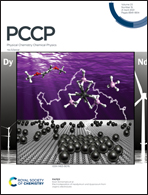A computational approach to understand the role of metals and axial ligands in artificial heme enzyme catalyzed C–H insertion†
Abstract
Engineered heme enzymes such as myoglobin and cytochrome P450s metalloproteins are gaining widespread importance due to their efficiency in catalyzing non-natural reactions. In a recent strategy, the naturally occurring Fe metal in the heme unit was replaced with non-native metals such as Ir, Rh, Co, Cu, etc., and axial ligands to generate artificial metalloenzymes. Determining the best metal–ligand for a chemical transformation is not a trivial task. Here we demonstrate how computational approaches can be used in deciding the best metal–ligand combination which would be highly beneficial in designing new enzymes as well as small molecule catalysts. We have used Density Functional Theory (DFT) to shed light on the enhanced reactivity of an Ir system with varying axial ligands. We look at the insertion of a carbene group generated from diazo precursors via N2 extrusion into a C–H bond. For both Ir(Me) and Fe systems, the first step, i.e., N2 extrusion is the rate determining step. Strikingly, neither the better ligand overlap with 5d orbitals on Ir nor the electrophilicity on the carbene centre play a significant role. A comparison of Fe and Ir systems reveals that a lower distortion in the Ir(Me)-porphyrin on moving from the reactant to the transition state renders it catalytically more active. We notice that for both metal porphyrins, the free energy barriers are affected by axial ligand substitution. Further, for Fe porphyrin, the axial ligand also changes the preferred spin state. We show that for the carbene insertion into the C–H bond, Fe porphyrin systems undergo a stepwise HAT (hydrogen atom transfer) instead of a concerted hydride transfer process. Importantly, we find that the substitution of the axial Me ligand on Ir to imidazole or chloride, or without an axial substitution changes the rate determining step of the reaction. Therefore, an optimum ligand that can balance the barriers for both steps of the catalytic cycle is essential. We subsequently used the QM cluster approach to delineate the protein environment's role and mutations in improving the catalytic activity of the Ir(Me) system.



 Please wait while we load your content...
Please wait while we load your content...